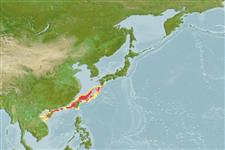分類 / Names
共通名の | 類義語 | Catalog of Fishes(部類, 種) | ITIS | CoL | WoRMS | Cloffa
>
Anguilliformes (Eels and morays) >
Synaphobranchidae (Cutthroat eels) > Ilyophinae
Etymology: Dysomma: Greek, dys, dyo = two + Greek, omma = eye; opisthoproctus: Species name refers to its posterior positioned anus (Ref. 31561).
Environment: milieu / climate zone / depth range / distribution range
生態学
海 底生の漂泳性; 深さの範囲 ? - 200 m (Ref. 31561). Subtropical
Northwest Pacific: known only from Nan-Fong-Ao, northeastern Taiwan.
サイズ / 重さ / 年齢
Maturity: Lm ? range ? - ? cm
Max length : 42.1 cm TL オス/雌雄の選別がない; (Ref. 31561)
簡単な記述
検索表 | 形態学 | 形態計測学
脊つい: 120. This species is distinguished by the following characters: with pectoral fin; dorsal-fin origin is in front of level of pectoral-fin base, predorsal length 10.6% TL; anus is posterior and far behind tip of pectoral fin, preanal length 35.1% TL; trunk is very long, trunk length 20.2% TL; intermaxillary teeth 2; compound teeth on vomer 4; multiple rows of small teeth on the upper jaw; a row of 7 or 8 large compound teeth on lower jaw; head pores: IO 4, SO 3, M 7, POP 0, AD 1; lateral-line pores: prepectoral 6, preanal 24, lateral line runs to more than 2 head length before caudal fin; 25 preanal vertebrae, 120 total vertebrae; colour of body brownish dorsally and paler ventrally with lower part of posterior margin of anal fin and caudal fin black (Ref. 31561).
Maximum depth reported based on a single specimen (Ref. 31561). Minimum depth from Ref. 58018.
Life cycle and mating behavior
成熟 | 繁殖 | 放精 | 卵 | 生産力 | 幼生
Chen, Y.Y. and H.K. Mok, 1995. Dysomma opisthoproctus, a new synaphobranchid eel (Pisces: synaphobranchidae) from the northeastern coast of Taiwan. Copeia 1995(4):927-931. (Ref. 31561)
IUCNのレッドリストの状況は (Ref. 130435: Version 2024-2)
Human uses
水産業: 興味がない
用具
特記事項
XMLをダウンロードして下さい
インターネットの情報源
Estimates based on models
Preferred temperature (Ref.
123201): 19.4 - 23.7, mean 21.7 °C (based on 40 cells).
Phylogenetic diversity index (Ref.
82804): PD
50 = 0.5001 [Uniqueness, from 0.5 = low to 2.0 = high].
Bayesian length-weight: a=0.00102 (0.00046 - 0.00225), b=3.06 (2.88 - 3.24), in cm total length, based on all LWR estimates for this body shape (Ref.
93245).
栄養段階 (Ref.
69278): 3.9 ±0.4 se; based on size and trophs of closest relatives
Fishing Vulnerability (Ref.
59153): Low to moderate vulnerability (32 of 100).
